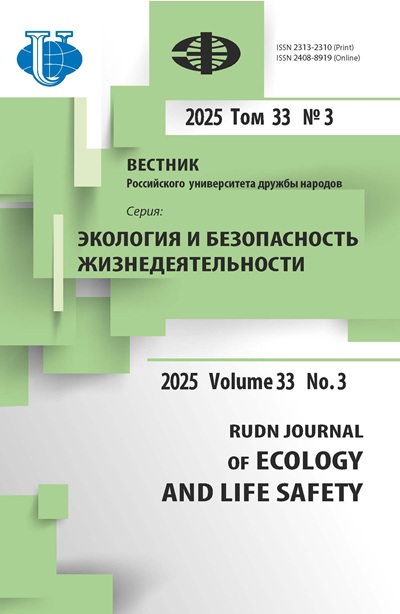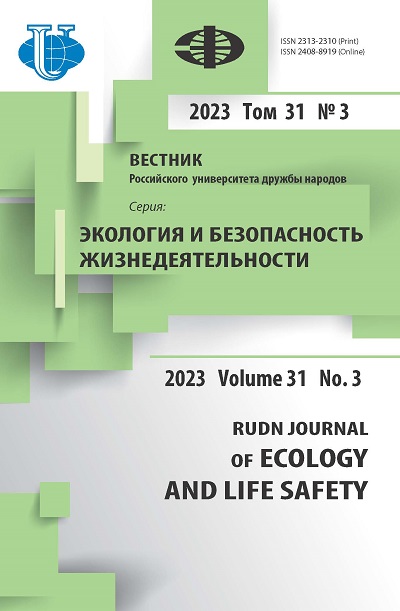Vol 31, No 3 (2023)
- Year: 2023
- Articles: 9
- URL: https://journals.rudn.ru/ecology/issue/view/1693
- DOI: https://doi.org/10.22363/2313-2310-2023-31-3
Full Issue
Ecology
Bryozoans in fouling communities on artificial substrates in Kazachya bay of the Black Sea
Abstract
Study of the formation of fouling communities on artificial substrates is actual due to the development of mariculture in the Black Sea. Some representatives of macrofoulers are able to influence the process of colonization and development of cultivated organisms. Purpose of work. The main tasks of the study are the revealing the peculiarities of the formation of the fouling community on the experimental plates of the various materials in the environment of the Kazachya bay in the Black Sea and the role of bryozoans in the fouling community. Materials and methods. The experimental plates which were made from the different materials (plastic, aluminum, rubber, galvanized iron) were installed in September 2017 at a depth of 5 m in Kazachya bay (Black Sea). The plates were lifted every month during the year, a total of 480 plates were examined. Results. The peculiarities of the formation of the fouling community on the experimental plates of different materials in the Kazachya bay (Black Sea) were studied. Totally, 22 species were found in the macrofouling community formed on the experimental plates in the Kazachya bay during the year, comprising the following 8 taxa: hydroid polyps - 1, barnacles - 1, sea anemones - 1, bryozoans - 4, polychaetes - 4, bivalve mollusks - 1, tunicates - 2, macrophytes - 8. During the year, the succession of the fouling community of the experimental plates developed through the stage of dominance of microorganisms - barnacle Amphibalanus improvisus , and then - bryozoan Cryptosula pallasiana. Conclusion: the bryozoan Cryptosula pallasiana is the dominant species in the fouling community at four to twelve months old at a depth of five meters.
 313-322
313-322


Study and analysis of the resistance of Enterococcus bacteria to antibiotics
Abstract
Enterococci have acquired resistance to almost all classes of antibiotics. The purpose of this study was to study and analyze the resistance of Enterococcus bacteria to antibiotics isolated from Vladivostok water bodies. The antibiotic resistance of 70 strains of the genus Enterococcus to such antibiotics as tetracycline, streptomycin, erythromycin, ampicillin, levofloxacin, rifampicin, gentamicin, vancomycin was studied by disco diffusion. It turned out that in b. In the b. Zolotoy Rog, more than half of the isolated strains were resistant to streptomycin, erythromycin, and levofloxacin, and in the r. Vtoraya Rechka, more than 50 % of the strains were resistant to streptomycin and rifampicin. The isolated population of enterococcal strains was characterized by multiple resistance to two antibiotics (41 %) in the Second River and three or more antibiotics (45 %) in the Golden River. The most common was resistance to a combination of antibiotics such as streptomycin, rifampicin and erythromycin.
 323-338
323-338


Assessment of ecosystem services for climate regulation: case study of the Madu Ganga wetlands
Abstract
The ecosystem services assessment plays one of the key role in the modern concept of sustainable development, including combat climate change and achievement carbon neutrality, since the value assessment of all benefits and risks from ecosystem services is the most visible for decision makers (business and government). Mangrove forests in developing countries, such as Sri Lanka, are important factor in achieving carbon neutrality. The purpose of present investigation was the economic assessment of climate regulation services on the example of the Madu Ganga wetlands (Sri Lanka). The carbon stock was calculated as the marginal cost of reducing carbon emissions, and the sequestration was assessed through the calculation of the carbon social cost or the marginal cost of damage. As a result, the high cost of carbon storage by the Madu Ganga wetlands was revealed - approximately, it amounted to $153,341,221. The cost of the ES for carbon sequestration was $2,153,424. The total cost of services to regulate the carbon cycle of the Madu Ganga wetlands was $155,494,645, or 0.18% of the nominal GDP of the island of Sri Lanka for 2021. The high value of the mangrove forests of Madu Ganga shows their crucial role in achieving carbon neutrality within the framework of the concept of sustainable development.
 339-348
339-348


Human ecology
Mercury concentration in the snow cover of the city of Khabarovsk
Abstract
The research reveals results of studies of the total mercury content in the snow cover of Khabarovsk in winter period 2021-2022. Researchers highlight a connection between mercury and non-soluble residue, with minor transition into soluble phase. The total mercury content in the non-soluble residue ranged from 0.3 to 1.4 mg/kg. On the northern border of the Bolshekhekhtsirsky Reserve, area with high content of quicksilver (3 mg/kg) was found, which exceeds the maxi-mum permissible concentration by 1.4 times. Authors consider that high concentration of quicksilver may be a result of short-term local pollution and do not exclude cross-border origin of it. Content of mercury as a part of solid atmospheric precipitation on the Earth’s surface in this area is 37.5 µg/m2, with average values of 10-18 µg/m2. The maximum content of mercury (73.9 µg/m2) was found nearby CHP-3 area. The reason is a high concentration of combustion products in snow cover. The amount of solid atmospheric precipitation in the area of CHP-1 also significantly exceeded the average values, but this did not lead to an increase in the total amount of mercury that reached the surface. The minimum concentration of quicksilver was found in the embankment park area of the city - 3.2 µg/m2.
 349-358
349-358


Environmental Monitoring
Analysis of the spatiotemporal fields of chemical soil pollution as a basic component of urban ecosystems
Abstract
The soil is a depositing medium and an indicator of geochemical load. The fulfillment of important ecosystem functions by urban soils ensures the ecological safety of urban ecosystems as a whole. The purpose of the work is to forecast soil pollution as a basic component of the urban ecosystem with a high level of technogenic load. The calculation of the spatio-temporal fields of chemical pollution of soils in the city of Kolchugino, Vladimir region, was carried out using a balance model based on ecological and analytical data utilizing the results of area surveys of soils and snow cover. The content of heavy metals of hazard classes 1 and 2 in soil and snow samples (solid and liquid phases) was determined by atomic absorption method according to standard methods. The analysis of spatio-temporal fields of soil contamination for each heavy metal is performed on the basis of map diagrams constructed using the INTEGRO GIS software-technological complex. Taking into account aerotechnogenic intake, an assessment of the degree of accumulation of heavy metals in soils and their time to reach the critical level is given. In the soils of Kolchugino, an excess of sanitary and hygienic standards (gross forms) is revealed for all the metals studied. Analysis of the data of spatio-temporal fields of soil pollution with heavy metals in the city of Kolchugino showed that the established level of soil pollution exceeding the MPC is primarily associated with the past economic activity of non-ferrous metallurgy enterprises and will remain at the same level in the near future.
 359-367
359-367


Ecological and chemical assessment of the state of the Desna river by bottom sediments on the example of the Bryansk region, Non-Chernozem region of the Russian Federation
Abstract
Studies of the state of bottom soils of the city Desna river (Bryansk) were carried out as part of the recommended studies of state environmental monitoring. The purpose of the work is to identify the current state of the urban watercourse on the basis of ecological and analytical indicators of bottom soils for diagnosing the state of the surface waters of the Desna river. The study of the bottom sediments of the Desna river in the reference areas (cross-sections) showed that the content of heavy metals is within the normal range. The exception is the section of the river in the background region. The excess of concentrations for cobalt and chromium is 8.0 and 1.1 times from the established standards. The highest content of titanium oxide, chromium and cobalt was noted in samples on the right bank of the Desna river in the background area, which indicates that the area is silty. On average, the excess of chromium in spring was 7.5 times, and in summer - 8 times. For cobalt, the excess of the indicator compared to the maximum allowable amounted to 1.1 times throughout the entire spring-summer period. For the first time, the data of three-year studies on the state of bottom sediments are summarized, allowing the development of effective environmental programs and the creation of a constantly updated monitoring base.
 368-380
368-380


Influence of runoff regulation on hydrochemical indicators of water in small rivers on the example of the Teplaya river in the Saratov region
Abstract
Small rivers are extremely sensitive to any anthropogenic activity, including runoff regulation, and serve as a kind of indicator of the ecological state of natural complexes. In general, large rivers are well studied, and small water bodies are practically not studied, although they are of great economic importance. For Teplaya river of the Saratov region was given an ecological and geographical characteristic, sources of anthropogenic load on the reservoir were identified, an analysis was made of the degree of knowledge and background indicators of the rivers of this basin. On the example of Teplaya river effect of runoff regulation of a small river by a dam on a number of physical and chemical parameters of pond water quality is considered. It has been established that the water temperature in the Teplaya river in the autumn period before the runoff regulation was a constant value, and after the dam it increased to the last sampling point downstream. The hydrogen index varied within 7.5-8.4, the total mineralization of water consistently increased in the studied section of the river (0.66-1.08 g/dm3). It is shown that the content of ammonium ions and nitrites was much higher than the sanitary and hygienic standards, which indicates the uniform nature of fresh organic water pollution in this section of the river. An increase in the concentration of chlorides in the last of the cascade of ponds was established - almost 1.5 times compared to the higher sampling points, which, however, did not exceed the standard values.
 381-389
381-389


Biological resources
Decomposition of individual components of bio-organic waste: volatile organic compounds and the impact on health and psycho-emotional state
Abstract
The study considers the impact on the person’s health and psycho-emotional state of unpleasant odors arising from the storage and accumulation of bioorganic waste, including food waste (meat, poultry, fruits and vegetables) and bird droppings. The survey data of poultry and livestock farms’ employees in Serbia are given. The impact of unpleasant odors on the Waste sorting complex (Moscow region) employees’ vital signs is assessed. The impact of high-intensity odor groups for individual components of food waste (pork meat, poultry meat, vegetables and fruits) and bird droppings was studied by interviewing volunteers and measuring their vital signs.
 390-406
390-406


NEWS
Expert opinion of the Institute of Environmental Engineering staff: what consequences can be due to the discharge of wastewater contaminated with tritium from the Fukushima Daiichi NPP into the ocean (Ph.D. in Economics, Assoc. V.E. Pinaev)
 407-412
407-412
















